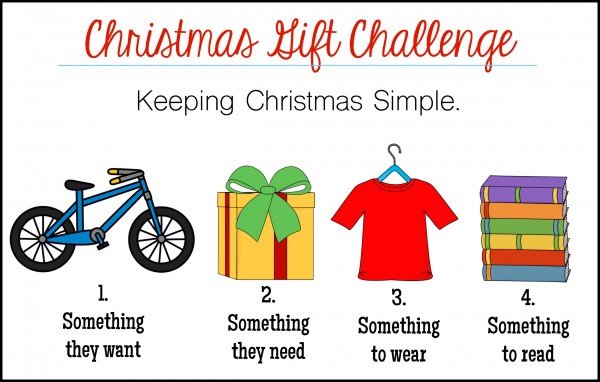I still remember getting an apple, an orange, and a crisp two-dollar bill one Christmas. When my great-grandfather handed us each a piece of fruit, I carried it to the car, tucked my cold feet on the heater, and compared the crisply scratched apple with the spicy rumpled skin of the orange.
A small gift, but it stayed in my mind.
And now that we’re grown, my friends and I face the dilemma of what to give to grown siblings, nieces and nephews, and friends. I hope this post’s ideas and reflections help when you’re deciding what to give!
Why do we give, and why wouldn’t we?
There are lots of reasons–it’s fun to prepare a gift you know someone will enjoy. They might need what you’re giving; you feel closer after giving; you can help someone out. Maybe giving is your “love language,” how you give and receive love. And most of all, opening prezzies can be fun!
Yet it can also be wise not to give one physical object to every person you care about:
- You might struggle to pay bills, or be saving for college, a house, or retirement.
- Anxiety and stress can make gifts feel like a duty and a chore.
- Americans spend $680 billion on holiday gifts, even as we claim that what we really want is time together.
- Many gifts end up in a landfill, year after year. As VDB says, “I have recently purged a massive amount of stuff from my house, many of which were gifts that I had never used.”
- What you spend on passing gifts could support a community cause, as in this lovely white card story.
- Exchanging gifts can distract us from listening, having fun, and getting to know each other in non material ways.
I know, I sound like a downer! But below are a number of options that seek to upset the status quo in some way:
1. One option is to only give non-physical gifts:
Take them to lunch. My grandma takes each of her grandchildren out for lunch, helping us to stay connected whenever we’re in town. Also works for niblings, siblings, and adult friends. If you’re short on money, inviting someone over to drink cocoa or make cookies is another option!
Pay for an outing. This year, my parents paid for Amos and I to visit the Dickens Fair near San Francisco, a costume fair set in 1850s London. One of my favorite birthday gifts was a ticket to see a ballet in Astana’s opera house; my friend Lauren reports enjoying show tickets and a massage.
Buy recurring gifts. Lauren’s family gives experience, such as zoo memberships or aquarium passes; Nicole gives her children colorful “membership cards” of their own even if the family only has one official card. Sharing a Netflix, Kindle, or Audible subscription could also be used all year long.
Buy lessons. Look for teaser courses in guitar, singing, ice skating, parkour, yoga, cooking, or art. These support local businesses and can also spark a new passion. I once received a lesson in aerial silks, a challenging sport that had me appreciating the poor feet of those in Cirque de Soleil!
Letters and videos. Compile and send appreciative letters to family or friends, or a birthday video with encouraging messages from friends who live far away.
Time spent together. Make your gift each year the invitation and supplies to make cookies, ornaments, dumplings, or gift bags!* Hosting a movie, game or caroling night will also stay in friends’ minds as a time of connection.
2. Giving to your own kids
Help kids send gifts back to Santa before they get more. If they’re going to live in a consumer society, it’s great to learn how to donate toys, books, and clothes they don’t love, early and often. They learn to give. It’s easier to clean up. And keeping only a few toys helps simplify their visual world, letting them play longer, learn more deeply, and have more fun!
Another ideas is to give your own children only four things: something they want, something they need, something to wear, and something to read.

My parents effectively did this with new pajamas each Christmas eve, a “book on the bed” for Christmas morning, and one or two craft or hobby gifts on Christmas day.
If you’re tight on money, you can buy these secondhand. And if you’re *cough* my grandmother, you might actually give library books which are due back to the local library three weeks later (!!).
3. Giving to nieces and nephews
An easy option is to draw straws, with each adult giving to one child or two children, especially as a family grows.
But group activity gifts are often more fun, and just as lovingly remembered:
- Our aunt J often sent quirky snacks from abroad for our whole family to share.
- Uncle B sent a box of hot chocolate, snacks, and a board game to play on Christmas.
- Aunt T bought a party pack of silly string, and gave each niblings a small can to spray each other silly with.
- Aunt T also folded dollar bills into a board of balloons and handed us each a dart. Trying to hit a balloon with a dollar in it was exciting, and a pinata or plastic wrap ball could be a similar group game involving candy or trinkets, and group fun!
If you do give to individual kids, Jill suggests you transitioning from individual gifts to a shared group activity in early elementary school, and then to joining in with family adult events in the child’s late teens.
4. Giving to Adult Siblings and in Friendship Groups
Cost and competition can be an issue here, yet giving is important in many families and groups. You can draw straws or rotate who gets a gift each year. But other options include:
Give the same small thing to each person. My aunt once gave each couple a memento book for their relationship. My baby sis-in-law painted a family portrait for each brother… starring herself, of course. This can still get expensive in a larger family.
Stuff stockings. Another idea is to give each person a small handmade treat or item you picked up over the year, collectively filling each others’ stockings. This can be especially helpful if parents no longer want to keep filling stockings, but you want to enjoy uncovering small gifts together!
Inspector gadget. We all buy cool tools we never use. If you’re prone to buying gadgets like a new banana slicer (!), ice cream maker, cake ball maker, heart-shaped waffle iron, or soda stream, why not pass it on after you’ve tried it once. Nice accessories, tools, DVDs, or board games could similarly be traded at a party, letting you pass along something high-quality but never used.
Drink exchange. I’ve participated in a tea exchange where librarians sent each other local tea and received boutique brands in return. If family or friends live far away, pack a light box with snacks, cocoa, cider, or tea to warm the winter months.
Help a fellow out. Offer to take family photos, repair a house, sort a closet, research a career, change car oil, review essays, mend clothes, tune up a computer, babysit, cook a meal, or cut hair for family and friends. You could even exchange gift certificates for skills in a yankee swap. It costs little but helps a lot.
Help someone else out. Another idea is to get together and make kits for folks in need. Students, cash-strapped young families, homeless folks, or older folks might all appreciate a gift basket or mix of useful goods. You can each buy or bring according to your ability, and work together as siblings or friends to spread the love in your community.
5. Ways to make giving more fun
And… if you do like gift-exchange games, there are better options than struggling to figure out a gift for a secret santa, or being annoyed that someone stole your gift at a white elephant swap! Try these:
Treasure hunt. My parents used to hide our gifts before Christmas morning, and hand each child a riddle… for where a different kid’s gift could be found! We had to work together to solve the puzzle, find the gifts, and open them.
Julklapp. If you live near friends and family, try this Swedish tradition of leaving surprise gifts and running away:
“a gift-giver would knock on his friend or relative’s door on Christmas Eve, quickly toss a present inside the opened door, then sprint away before the recipient had a chance to ID him. The mysterious packages were wrapped in many layers, one box inside another. Sometimes the only thing inside the final box was a clue to the real gift’s location. The more time the recipient spent on figuring out who gave the gift and where it was, the more successful the julklapp.” – Real Simple
Cobweb party. Finally, try a Victorian party game in which you tie a long colorful yarn or ribbon to each (hidden) small gift, then weave the threads together in a giant cobweb around the room. Each person picks a color and unravels it to find their gift!
~~~~~~
(A colorful, easy, and durable option for gift wrapping is to use fabric bags instead of throwaway paper. Make yourself or buy here, here, here, and here. Or, wrap gifts creatively in fabric in a Japanese style!)
